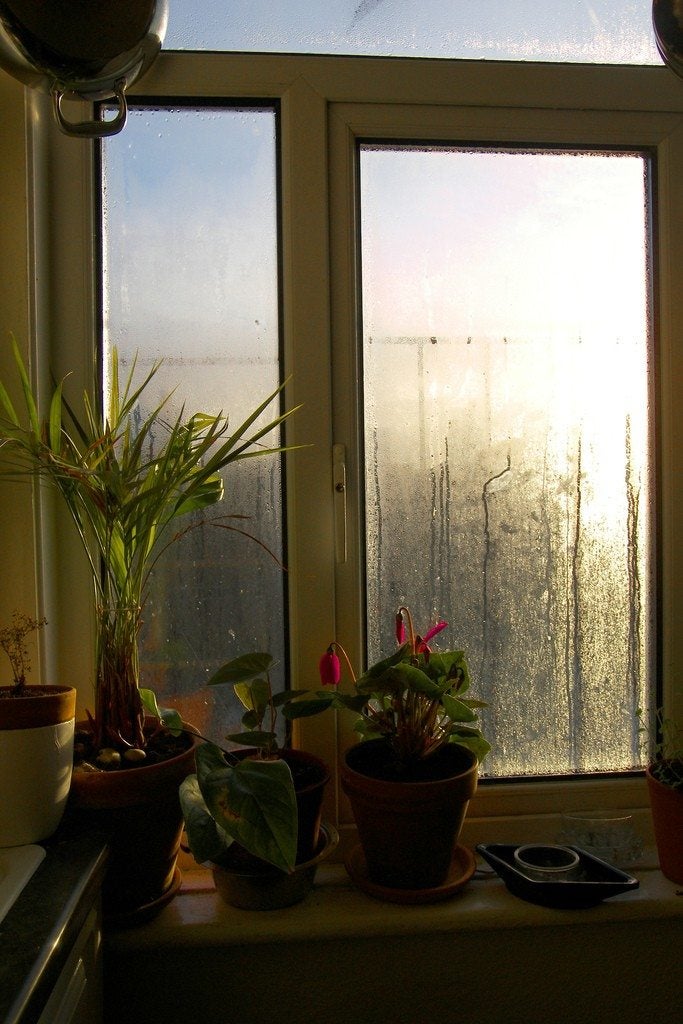Reducing Humidity Indoors: What To Do When Humidity Is Too High


There are lots of tips and tricks for keeping indoor humidity levels high, especially in the close vicinity of plants that need lots of humidity, like orchids. What do you do if your indoor humidity is too high though? As insulation techniques improve the seals on homes and greenhouses across the country, reducing humidity becomes a vital task. Not only does high indoor humidity increase the risk of damage to your home, it can cause problems for your plants.
Can High Humidity Hurt Plants?
There are some plants that are natives to sweltering tropical locales and love nothing more than air so thick with moisture that a normal person can barely breathe, but your typical indoor plants aren't among them. High indoor humidity levels cause serious problems for most inside plants by encouraging the growth of fungal and bacterial diseases, which often need very high humidity to infect tissues. The same goes for plants in greenhouses --greenhouse humidity control is vital to preventing the spread of disease. Splashing water caused by nighttime condensation further increases the risk of moving spores from infected plants to clean specimens nearby. Active disease can ravage your greenhouse plants and destroy months or years of work.
How to Reduce Indoor Humidity
Reducing indoor humidity in the home is sometimes a much easier task than in the greenhouse, since there's not as much water being constantly added to the environment. Homeowners with high humidity should check that their central air conditioning and heating are working properly --these systems are very good at helping to maintain a reasonable level of humidity. Checking your pipes, basement, and crawlspaces and other potentially cold surfaces for condensation may eliminate another source of moisture in the air. If surfaces are sweating, they can be insulated to put a halt to the formation of water that may be damaging your home and hurting your plants. Greenhouse operators have other options for humidity control and should increase the air circulation in the greenhouse right away. Watering less frequently and improving the drainage in your greenhouse will eliminate sources of excess moisture that may end up in the air. Adding bottom heat to plants to create microclimates will help prevent condensation on plant surfaces, reducing the risk of disease exponentially.
Gardening tips, videos, info and more delivered right to your inbox!
Sign up for the Gardening Know How newsletter today and receive a free copy of our e-book "How to Grow Delicious Tomatoes".

Kristi Waterworth was a regular contributor to Gardening Know How for many years, answering countless queries on plant pests and diseases.
-
 5 Tough Urban Trees That Thrive In Cities – Top Picks For Urban & Suburban Landscapes
5 Tough Urban Trees That Thrive In Cities – Top Picks For Urban & Suburban LandscapesExplore the best urban trees that will add value to even the most challenging of landscapes. Get growing with these ideas and enjoy all the benefits of trees.
By Teo Spengler
-
 7 New & Improved Cultivars Of Old-Fashioned Plants – These Aren’t Your Grandma’s Plants!
7 New & Improved Cultivars Of Old-Fashioned Plants – These Aren’t Your Grandma’s Plants!Old is new again! These old-fashioned plants have new cultivars that are sure to thrive in your garden and bring the charm factor. Neighbors will be envious!
By Mary Ellen Ellis
-
 8 Easy Care Houseplants That Live A Long Time
8 Easy Care Houseplants That Live A Long TimeClick here to learn about our 8 favorite low maintenance houseplants that can, with proper care, live a long time.
By Amy Grant
-
 How Often Should You Repot Plants?
How Often Should You Repot Plants?Escaping roots and shrinking leaves may mean your plant wants a new pot, but some like staying cramped and cozy.
By Mary Ellen Ellis
-
 Orange Flowering Houseplant Varieties With Tropical Flair
Orange Flowering Houseplant Varieties With Tropical FlairClick here to learn about some cheerful orange-blooming houseplants you can try growing.
By Mary Ellen Ellis
-
 Variegated Houseplants With Lovely Leaves
Variegated Houseplants With Lovely LeavesWhat are some of the best variegated houseplants to add to your collection? Click here to find out.
By Amy Grant
-
 Lovely, Lacy Indoor Foliage Plants
Lovely, Lacy Indoor Foliage PlantsClick here to learn about some houseplants with lacy foliage to add to your collection.
By Mary Ellen Ellis
-
 Best Christmas Houseplants And Plants For Winter Holidays
Best Christmas Houseplants And Plants For Winter HolidaysClick here for an idea of the best houseplants to use for holiday décor for Christmas, Hanukkah, Kwanzaa, and New Year’s.
By Laura Miller
-
 Best Big Houseplants To Create An Indoor Oasis
Best Big Houseplants To Create An Indoor OasisIf you have the space you may want to grow some large houseplants. Here are some ideas.
By Mary Ellen Ellis
-
 Relaxing Plants To Grow Indoors For A Calmer Mind
Relaxing Plants To Grow Indoors For A Calmer MindAre there houseplants that can help you to relax? Click here to find out.
By Laura Miller